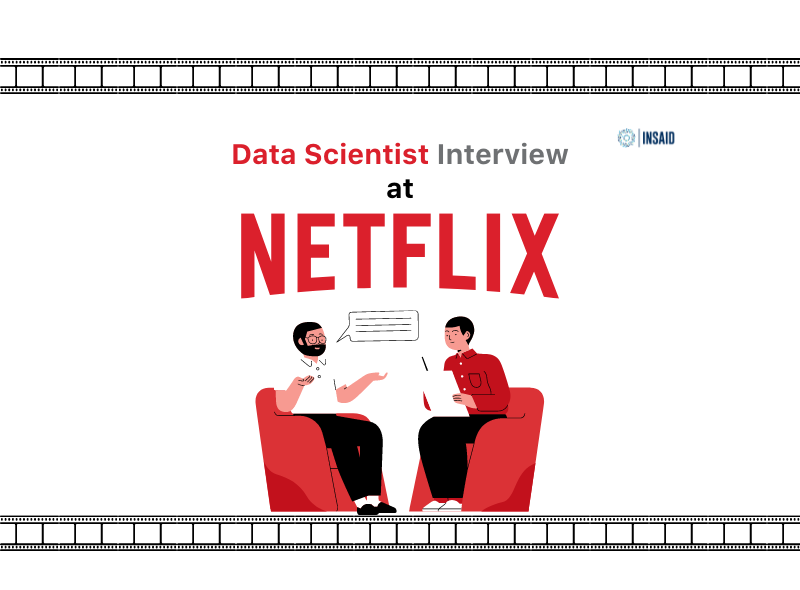Netflix is the largest streaming media company in 2022. With many devices and around 3 billion hours watched every month, lots of data is collected from 100 billion events per day. Therefore, Netflix has been hiring Data Scientists on a large scale.
Data Science is at the core of Netflix and it requires Data Science to improve every aspect of their customer experience. Netflix has over the years been using Data Science for its content recommendation engine, to plan on what content to produce and to constantly improve user experience.
What does a Data Scientist do at Netflix?
Netflix has Data Scientists working with over 30 different teams including Marketing Analytics team, Algorithms, User Personalization, and the Product Research and Tooling team.
The skill sets range from basic analytics to heavy machine learning algorithms. Even then, the roles of a Data Scientist at Netflix are mostly specialised as per the team they eventually become a part of.
How do the interviews at Netflix take place?
Like every tech company, the interview process for a Data Scientist position at Netflix is the same. It begins with, you receiving a call from a recruiter or a hiring manager for an initial interview, a round of technical interview and finally an onsite interview with 5-6 people.
Netflix Data Scientist interview rounds
Round- 1 Phone interview
The initial screen at Netflix is a 30 minute phone call with a recruiter. The recruiters at Netflix are highly specialized and very technical. Their job is to understand your resume and see if your past experience, projects, and skill set matches up to the role.
The second point for this part of the interview is to test your general communication and problem solving skills and also explain the specifics of the role. You will also be subjected to technical questions related to your past projects and how you have applied Data Science and Machine Learning for them.
Netflix is particular about work culture and values, therefore you may be asked to pick a value and explain how it suits you in the best way.
Pro Tip: Please read through the Netflix culture page here, and be thoroughly prepared to answer questions based on it.
Round- 2 Technical interview
The technical screen is the next step in the interview, after you have successfully cleared round 1. This is usually a 40-60 minute interview which involves technical questions from SQL, experimentation and ab testing, and machine learning.
One should expect at least 2-3 coding like questions, which can either involve algorithm type or an SQL type. The coding portion is done via a shared code editor online. The questions can be like:
- What are the differences between L1 and L2 regularization, why don’t people use L0.5 regularization for instance?
- What is the best way to communicate ML results to stakeholders?
- How do you inspect missing data and when are they important?
Pro Tip: This is where your background knowledge of SQL and Python skills will come in handy and help you set apart and secure a spot.
Round- 3 Onsite interview
The onsite interview is the last and the longest round of them all. This usually takes a whole day of 6 back to back interviews. You will be interviewed by professionals from various departments, namely Data Scientists, HR’s, team leads, Product managers and business executives.
The onsite interview is a combination of product, machine learning, and various analytical concepts. If the role is focused more on engineering, expect to answer machine learning and possibly deep learning related questions.
Pro Tip: Practice case study questions about Netflix and make sure to share your thoughts during the interview.
 Pin
Pin20 Frequently asked questions by interviewers at Netflix
Here is a chunk of questions that have been asked in the past for a Data Scientist interview:
EASY
- Write SQL queries to find a time difference between two events.
- Find max sum subsequence from a sequence of values.
- What are the different regularization metrics L1 and L2?
- Can you explain the Naive Bayes Fundamentals? How did you set the threshold?
- How do you detect if an observation is an outlier?
INTERMEDIATE
- Write the equation for building a classifier using Logistic Regression.
- Given a month’s worth of login data from Netflix such as account_id, device_id, and metadata concerning payments, how would you detect payment fraud?
- How would you design an experiment for a new content recommendation model we’re thinking of rolling out? What metrics would matter?
- How would you build and test a metric to compare two users’s ranked lists of movie/tv show preferences?
- Why is Rectified Linear Unit a good activation function?
- How would we approach attribution modeling to measure marketing effectiveness?
- How would you determine if the price of a Netflix subscription is truly the deciding factor for a consumer?
- How do you find percentile? Write the code for it.
- What is the bias-variance trade-off?
- Discuss how to randomly select a sample from a product user population.
- How important is the accuracy on training data vs testing data?
- What do you mean by bagging and boosting? What is the key difference in the classifiers involved?
HARD
- How would you select a representative sample of search queries from five million?
- If Netflix is looking to expand its presence in Asia, what are some factors that you can use to evaluate the size of the Asia market, and what can Netflix do to capture this market?
- Does k-means converge to a global solution? If yes, can you give the intuition? If not, are there strategies we can use to get better clusters using k-means?
We hope by reading this blog you have gained a fair understanding of the Data Scientist interview process at Netflix. Please feel free to check out more such blogs here.







